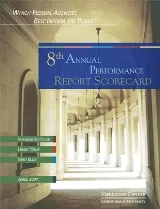- | Policy Briefs Policy Briefs
- |
8th Annual Performance Report Scorecard: Which Federal Agencies Best Inform the Public?
This year, America celebrates the 400th anniversary of the settlement of Jamestown - a colony that almost perished due to a crisis of accountability. The legendary Captain John Smith solved the

Summary
This year, America celebrates the 400th anniversary of the settlement of Jamestown - a colony that almost perished due to a crisis of accountability. The legendary Captain John Smith solved the accountability problem and also pioneered performance reporting. Though his initiatives predated the Government Performance and Results Act by 385 years, they satisfied many of the prerequisites for successful performance management. Beneficial outcomes were well defined, performance measures were clear, causation was well understood, and performance was transparently linked to consequences.
Today's federal government is more complex than Jamestown. That makes effective accountability more difficult, but the same basic principles apply: define outcomes, define measures, understand how activities affect outcomes, and link outcomes to costs and consequences.
The Government Performance and Results Act of 1993 requires agencies to produce strategic plans, annual performance plans, and annual performance reports. This Scorecard commenced in fiscal 1999 to foster continuous improvement in the quality of disclosure in agencies' annual performance reports. This year, researchers at the Mercatus Center at George Mason University conducted our eighth annual evaluation of the performance and accountability reports produced by the 24 agencies covered under the Chief Financial Officers Act. These agencies accounted for 99 percent of federal outlays in 2006. We employed the same criteria as used in previous Scorecards.
Key findings in this year's Scorecard include:
- Agencies with reports receiving average scores below satisfactory accounted for 87 percent of non-interest federal spending in fiscal 2006.
- A significant quality gap emerged between the top four reports and the rest.
- The average total score has remained stagnant for the past three years.
If you would like to download only a section of the report, instead of full document at the top of the page, please click on one of the following links.
Part I: Executive Summary and Rankings
Part II: Introduction and Scoring Standards
Part III: Scoring Summary
Part IV: Toward Comprehensive Accountability
Part V: Strongest and Weakest Scores
Part VI: Agency by Agency Scoring Highlights
Part VII: Research Team and Project Design
Related Documents:
Dr. Jerry Ellig's Presentation (Powerpoint from the release event)

